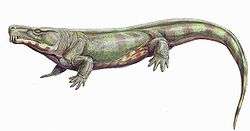Limnoscelis
| Limnoscelis Temporal range: Early Permian | |
|---|---|
 | |
| Limnoscelis paludis | |
| Scientific classification | |
| Kingdom: | Animalia |
| Phylum: | Chordata |
| Superclass: | Tetrapoda |
| Class: | Amphibia sensu lato |
| Order: | Reptiliomorpha |
| Suborder: | Diadectomorpha |
| Family: | Limnoscelidae |
| Genus: | Limnoscelis Williston, 1911 |
| Species | |
| |
Limnoscelis is a genus of large (1.5 m in total length),[1] very reptile-like diadectomorph (a type of reptile-like amphibian) from the Early Permian of North America. Contrary to other diadectomorphans, Limnoscelis appear to have been a carnivore. Though the post cranial skeleton is very similar to the early large bodied reptiles like pelycosaurs and pareiasaurs, the digits lacked claws, and the bones of the ankle bones were fused like in other reptile-like amphibians. This would not allow them to use their feet actively in traction, but rather as holdfasts, indicating Limnoscelis primarily hunted slow moving prey.
Gallery
 Limnoscelis
Limnoscelis-RedpathMuseumMontreal-June6-08.png) A cast example of Limnoscelis, on display at the Redpath Museum, Montreal.
A cast example of Limnoscelis, on display at the Redpath Museum, Montreal. Limnoscelis skeleton.
Limnoscelis skeleton.- Limnoscelis skeleton in the Milan Natural History Museum.
Sources
- Bringing Fossils To Life: An Introduction To Paleobiology by Donald R. Prothero
This article is issued from Wikipedia - version of the 7/12/2016. The text is available under the Creative Commons Attribution/Share Alike but additional terms may apply for the media files.

